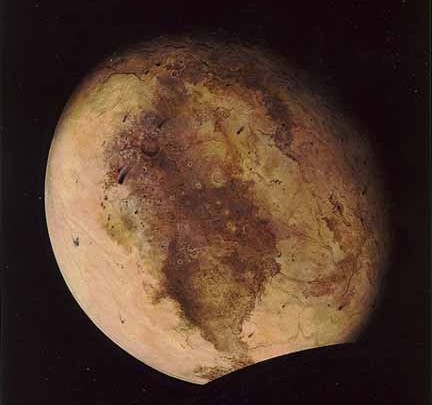Search site
Contact
E-mail: ameyali.pineda@gmail.com
Space Report

Pluto
By: Ameyali Pineda
The planet I am writing about is Pluto, I chose Pluto because I am familiar with the reasons it’s a dwarf planet, however that’s about all I know about Pluto. I am going to write about all other facts about Pluto that people don’t really know.
My planet was discovered in 1930, in 1905 Percival Lowell, who was an American astronomer, discovered that a force of gravity coming from an object unknown was affecting the orbits of Neptune and Uranus. He predicted in 1915 the location of a new planet, and began searching for it from his observatory in Flagstaff, Arizona; he photographed the area using a telescope. After his death in 1916, another astronomer, Clyde W. Tombaugh, an assistant at the Lowell Observatory, used predictions of Lowell and other astronomers. He started looking in 1929, and found it in 1930. The planet is named after the Roman god of the dead. We still need to find more precise information about its size, temperature and other facts.
As many people know, Pluto was the smallest planet in our solar system, up until 2006, when the International Astronomical Union classified it as a plutiod (or dwarf planet). Though astronomers still do not know much about Pluto’s size, nor its surface conditions. It has an estimated diameter of about 1,400 miles (2,300 kilometers) that is less than a fifth of Earths diameter. Pluto has one moon, Charon. Pluto is mostly brown and seems to be partially covered by frozen methane gas, it also appears to have a thin atmosphere it too is made mostly of methane. Pluto’s density is low and that is why astronomers think that Pluto is mainly ice or icy.
Astronomers don’t really know what Pluto is made of, only really what the surface is made of, methane and ice. You most likely wouldn’t find any life on Pluto. Pluto’s atmosphere is thin and is also made mostly of methane. The whole planet is really just a little ball of ice and methane gas.
Since Pluto of course is very far from the sun, it takes a while for Pluto to rotate around the sun. Pluto goes around the Sun in an oval shape, and every 248 Earth years, and it takes 6 (Earth days Pluto to spin on its axis. It is believed by astronomers that Pluto’s temperature could be about -375 degrees F (-225 degrees C). Due to the fact that Pluto cuts into Neptune’s orbit, Pluto was classified as a dwarf planet because a planet needs to have its own path of orbit.
I had always known that Pluto was a dwarf planet and why it was a dwarf planet, but never about how it was found or who found it. Why I never even knew about its moons! Which are Charon, Hydra, and Nix. It was rather interesting that Pluto is made mostly of methane gas and ice. Most people think about Pluto as the littlest planet, but now I think of Pluto as a very interesting planet!
 6A4CE-gravitational-attraction.gif (8 kB)
6A4CE-gravitational-attraction.gif (8 kB)

Gravitational Attraction
By: Ameyali Pineda
Gravitational attraction is the force that makes it almost impossible to feel the Earth spin on its axis, and gravitational attraction is what causes the Earth’s tides. The equation that shows Newton’s conclusion about the magnitude of gravitational forces is .
If you’ve heard the story of the apple falling from the tree, then perhaps you know that Newton knew that the apple’s gravity had to be dependent on the apples mass. The force that caused the apple to go down also causes the Earth’s acceleration upward, which is Isaac Newton’s third law. That mass forcer also depends on Earth’s mass.
However Newton’s law of gravitational attraction stretches far beyond Earth’s gravity. The gravitational attraction from one proton doesn’t just attract one electron but all other electrons and protons in the universe. The gravitational attraction that occurs between all particles of matter always is continuous and is always unbroken.
Then how can we pick up an object, if gravity should be holding it down? Well, if you were to pick up say, a TV remote, the reason you can pick up it up is because you have greater mass than a remote. Let it go, and the remote will fall on the floor because the ground below you has greater mass therefore the amount of gravitational attraction between the floor and remote is greater.
Gravitational attraction actually does exist in the universe, it’s what keeps the planets the way they are what makes the satellites (moons) circling around planets. It causes the tides, the gravitational pull between the earth and the moon. If it were not for gravitational attraction, we would have no moon. Without the moon there would be no human beings on earth.
Gravitational attraction is what keeps us down and what makes our planet different from all other planets. It also is what makes sure we don’t suddenly start floating around in the cabin of a plane. Though at the same time it means humans have to defy gravity with these machines that go into the sky. Of course that all changes when we get into space, where gravitational attraction only exists between planets and their moons. Gravitational attraction is what makes this planet just the right one.
Bibliography
- https://solarsystem.nasa.gov/planets/profile.cfm?Object=Pluto&Display=Kids
- https://solarsystem.nasa.gov/planets/profile.cfm?Object=Pluto&Display=Facts
- https://solarsystem.nasa.gov/planets/profile.cfm?Object=Pluto&Display=Gallery
- https://solarsystem.nasa.gov/planets/profile.cfm?Object=Plu_Charon
- https://solarsystem.nasa.gov/planets/profile.cfm?Object=Pluto&Display=OverviewLong
- https://solarsystem.nasa.gov/planets/profile.cfm?Object=Pluto
- https://www.nasa.gov/multimedia/imagegallery/image_feature_267.html
- https://www.nasa.gov/audience/forstudents/5-8/features/F_The_Planet_Venus_5-8.html
- https://www.nasa.gov/worldbook/venus_worldbook.html
- https://www.nasa.gov/worldbook/pluto_worldbook.html
- https://circlon-theory.com/HTML/mythofgravattr.html
- https://www.physicsclassroom.com/Class/circles/u613c.cfm
- https://www.enchantedlearning.com/subjects/astronomy/planets/pluto/
My fifth grade partners website:
https://greenday1234.weebly.com/
© 2009 All rights reserved.
